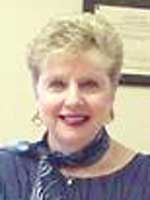REGIONAL
Superintendent Series:

Dr.
Kathleen Cashin, Region 5
by Joan Baum, Ph.D.
“Dynamo” hardly begins to describe
the focused, fast-talking, dedicated “workaholic”—the
word she uses to describe her assistants—but clearly
the apple doesn’t fall far from the tree. For Region
5 Superintendent, Kathleen Cashin, the energy level starts
high and accelerates as she talks of changes she has been able
to bring about in only one year as regional superintendent,
but it’s clear she draws on vigorous and efficient leadership
she has exercised in previous positions as teacher, staff developer,
consultant, program manager, and principal in city schools,
and then as superintendent of Community School District 23
in Queens. Such is her enthusiasm and impatience to turn things
around that it’s not always immediately apparent what
time frame she’s in: plans become part of a present-tense
onslaught on complacency. Only one of the 102 schools under
her aegis (including 12 high schools), for example, was labeled
problematic, though many of the schools because of low socio-economic
conditions, neglected for so long, might be thought of as inevitable
candidates for the endangered list. The superintendent ticks
off some of the areas served by Region 5, among them The Rockaways,
Beach Channel, Broad Channel, East New York, Brownsville, then
points out that her district, encompassing 120 square miles,
is the largest geographically in the city.
She cites three main
attributes that make for effective administration—intense professional will (commitment
above and beyond), restraint (knowing when to be tough, when
to back off), and modesty (recognizing that others may have
better ideas). She might well have added a fourth: contagious
drive. Kathleen Cashin knows what she wants and is determined
to get it…now. “Restructuring,” she says,
has made the difference, small schools made out of large, unwieldy
ones. But imagination is also at play—the new entities
have and will have special themes, such as civil rights, world
health, the arts—and partnering with the Teacher Center,
for example, has made possible the “most unbelievable
professional development,” new arrangements with CUNY
and more subject specialists serving as “liaisons” to
individual schools.
Centering her attention
on grades K-8 (the usual structure in parochial and private
schools), but allowing that in some cases middle schools
work well, Dr. Cashin says that K-8 usually furnishes the
better model because of the advantage of extended time. K-8
schools also have better attendance records and less violence
than most middle schools. But Dr. Cashin moves closely on
phasing in new policies and procedures, usually starting
with K-6 and then adding a grade at a time. Central in her
efforts have been the Scholars’ Academy, attracting
gifted children who apply and go through a rigorous admissions
process, and the Channel View School for Research (also for
grades 6--12). Also in the works, thanks to collaboration with
Borough President Helen Marshall, says Dr. Cashin, is a CUNY
Satellite school, which will have social studies as its concentration.
The Scholars’ Academy is a particular source
of pride for Dr. Cashin since it attracted 500 parents at an
open meeting, 90 percent of whom are non-white. Many parents
of successful applicants sign a “contract” pledging
regular support. They know they have something special. In
addition to interdisciplinary study starting with ancient civilizations
this fall, there will be four different languages studied as
part of a cycle, beginning with American Sign Language. Dr.
Cashin, a life-long athlete, is also a strong believer in sports,
particularly non-traditional sports such as Lacrosse, possible
sources for college scholarships.
All the schools under
Dr. Cashin’s purview
will reflect her passion for a New York State standards-based
core curriculum that is also interdisciplinary and that will
involve portfolio assessment. At the Beach Channel School,
for example, on the Bay, research will turn on oceanography
and horticultural study, supplemented with hands-on activities
and collaborations with institutions such as the New York Aquarium.
The Superintendent is thrilled with the initiatives, to say
the least, and feels that the new city structure, whereby 10
regional heads have replaced 31 district leaders, creates a
tighter, more personal and collegial environment for success.#
